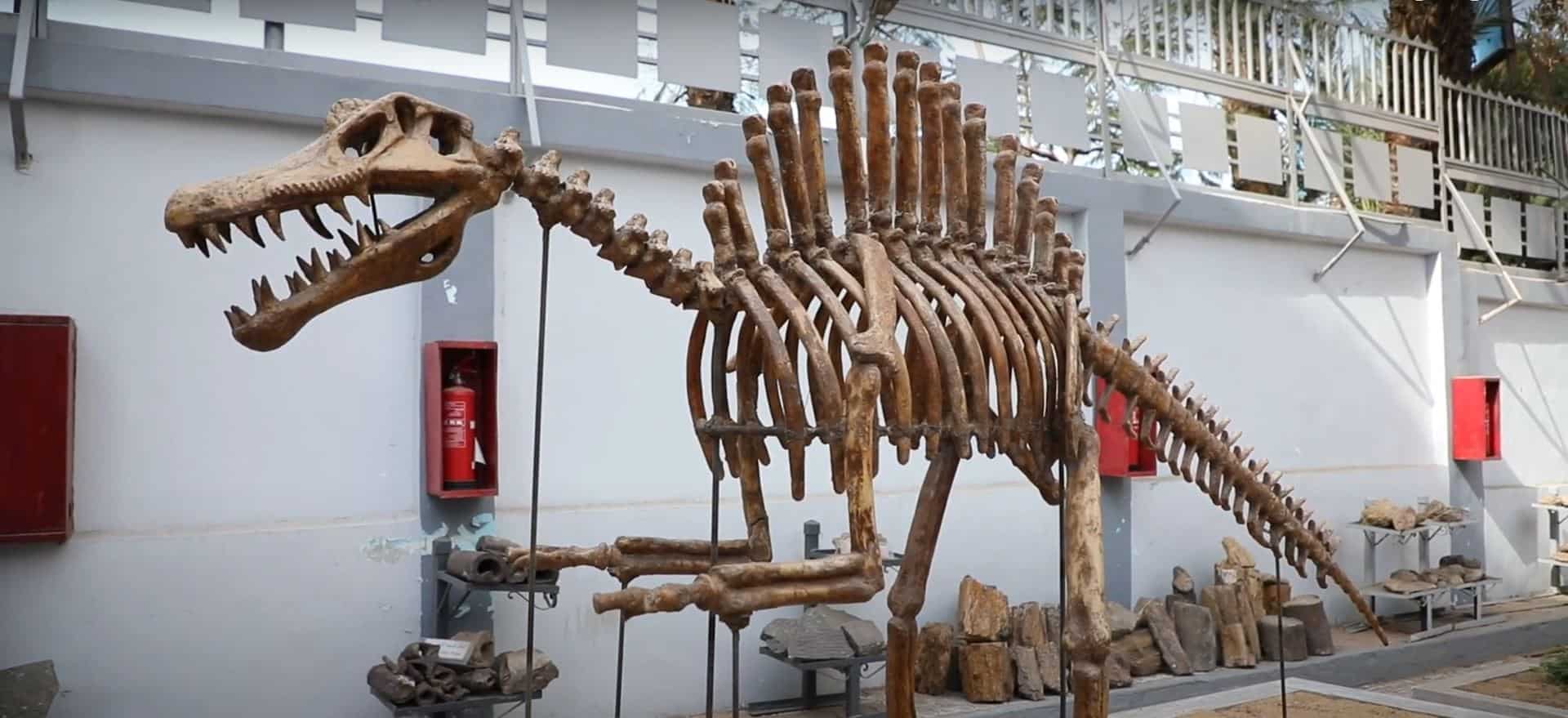Egyptian Geological Museum – Cairo – Egypt

Updated On: April 18, 2024 by Maha Yassin
Cairo, the sprawling capital of Egypt, is renowned for its rich history, captivating culture, and awe-inspiring landmarks. While the Pyramids of Giza and the Sphinx may steal the limelight, a hidden gem appeals to those with a fascination for the Earth’s geological wonders: the Egyptian Geological Museum. Nestled in the heart of Cairo, this museum is a treasure trove of geological specimens, fossils, and scientific exhibits. It provides visitors with a captivating journey through Egypt’s geological past and its profound impact on our understanding of the Earth’s history. In this article, we will take you on a virtual tour of the Egyptian Geological Museum, shedding light on its history, collections, and significance in geology.
Unveiling the Geological Treasures of the Egyptian Geological Museum
The Egyptian Geological Museum, also known as the Geological Museum of the Egyptian Geological Survey and Mining Authority (EGSMA), has a rich history dating back to the early 20th century. It was established in 1904, making it one of the oldest geological museums in the world. The museum was conceived to showcase Egypt’s geological wealth and contribute to scientific research and education.
Located in the EGSMA building, which itself is an architectural marvel, the museum boasts a strategic position in the heart of Cairo, making it easily accessible to both locals and tourists. Over the years, the museum has undergone several renovations and expansions to accommodate its ever-growing collection and enhance the visitor experience.
Collections and Exhibits
The Egyptian Geological Museum is home to a diverse and impressive array of geological specimens, fossils, and exhibits that span various geological epochs. Here are some of the highlights that visitors can expect to encounter during their visit:
- Mineral and Rock Specimens: The museum’s mineral and rock collection is a geological enthusiast’s dream come true. It features an extensive display of minerals and rocks from all over Egypt, showcasing the country’s geological diversity. The collection offers a comprehensive overview of Egypt’s geological composition, from shimmering quartz crystals to intricate basalt formations.
- Fossils: One of the museum’s most intriguing sections is dedicated to fossils. Egypt’s unique geological history has produced a wealth of fossils that provide insights into ancient life forms and environmental conditions. The collection includes fossils of prehistoric marine creatures, dinosaurs, and even early human ancestors. Notable specimens include the remains of ancient whales found in Egypt’s Western Desert and the famous Bahariya Oasis fossils.
- Meteorites: The museum houses a remarkable collection of meteorites for those interested in celestial geology. These extraterrestrial rocks provide a fascinating glimpse into the universe beyond our planet. Some meteorites on display are rare and come from various meteorite showers in Egypt.
- Geological Maps and Models: The museum doesn’t limit itself to static exhibits. It also offers interactive and educational displays, including geological maps and models. These aids help visitors understand the geological features of Egypt and appreciate the processes that have shaped the landscape over millions of years.
- Scientific Research: The museum is not merely a place for displaying geological wonders; it also plays a crucial role in advancing scientific research. Researchers and scientists often visit the museum to study its extensive collection, contributing to our understanding of Egypt’s geological history and its implications for the broader geology field.
- Educational Programs: The Egyptian Geological Museum is committed to promoting geological knowledge among the public. To this end, it organizes educational programs, workshops, and lectures for students, teachers, and the general public. These initiatives aim to foster a greater appreciation for Earth sciences and inspire the next generation of geologists.
Significance in Geology
The Egyptian Geological Museum holds immense significance in the world of geology for several reasons:
- Preservation of Geological Heritage: The museum is a custodian of Egypt’s geological heritage. By carefully curating and maintaining its collections, it ensures the preservation of invaluable specimens and fossils for future generations of geologists and scientists.
- Contributions to Research: The museum’s collections have contributed significantly to scientific research. Fossils and geological samples housed here have been instrumental in advancing our knowledge of Earth’s history, including the evolution of life forms and changes in climate and environment.
- Educational Hub: As a hub for education and outreach, the museum plays a pivotal role in disseminating geological knowledge. It offers a platform for students, researchers, and enthusiasts to engage with the field of geology, fostering a deeper understanding of our planet’s processes.
- Tourist Attraction: While the Egyptian Geological Museum primarily caters to the scientific community, it attracts tourists interested in geology, palaeontology, and Earth sciences. This contributes to the cultural and educational tourism landscape in Cairo.
Visitor Experience
Visitors to the Egyptian Geological Museum can expect a memorable and educational experience. The museum’s well-organized exhibits, informative signage, and knowledgeable staff make it accessible to individuals with varying geological expertise.
Upon entering the museum, visitors are greeted by a breathtaking display of minerals and rocks that highlight the geological diversity of Egypt. The fossils section, complete with ancient marine reptiles, dinosaur bones, and prehistoric plant specimens, often leaves visitors in awe of the Earth’s ancient history.
The meteorite collection is another highlight, with specimens that have travelled vast distances through space before landing on our planet. These celestial rocks provide a unique perspective on Earth’s place in the cosmos.
Interactive exhibits and hands-on activities are also available for younger visitors and those seeking a more engaging learning experience. These activities include fossil casting, mineral identification, and geological puzzles.
Guided tours are available for those seeking a deeper understanding of the museum’s collections, allowing visitors to explore the exhibits with the guidance of knowledgeable museum staff.
When to Visit Cairo for the Perfect Trip
The best time to visit Cairo, Egypt, is during the spring (March to May) and autumn (September to November) when the weather is most pleasant. Cairo experiences mild temperatures during these seasons, making outdoor activities and sightseeing comfortable. Spring brings blooming flowers and the joy of mild weather, while autumn offers a gradual cool-down after the scorching summer.
Crowds are typically smaller than during peak tourist season, allowing visitors to explore the city’s iconic attractions without long waits. While winter (December to February) is also a viable option with mild temperatures during the day, it’s the peak tourist season, leading to larger crowds. Summer (June to August) can be sweltering, making it less favourable for outdoor activities. Still, it can offer budget-friendly options for those willing to brave the heat and experience Cairo with fewer tourists.
Attractions Around the Egyptian Geological Museum
The Egyptian Geological Museum is located in Cairo’s bustling city centre, and there are several other attractions and places of interest nearby that you can explore to make the most of your visit to this historic city. Here are some notable attractions in the vicinity:
- Cairo Opera House: Just a short walk from the museum, the Cairo Opera House is a cultural hub that hosts a variety of performances, including classical music, opera, ballet, and theatre. Check the schedule to see if there’s a performance during your visit.
- Giza Plateau: No visit to Cairo is complete without seeing the awe-inspiring Pyramids of Giza, including the Great Pyramid and the Sphinx. They are a short drive from the city centre and offer a fascinating glimpse into ancient Egyptian history.
- Egyptian Museum: The Egyptian Museum in Tahrir Square is home to an extensive collection of ancient Egyptian artefacts, including the treasures of Tutankhamun. It’s a must-visit for history enthusiasts and within walking distance from the Geological Museum.
- Coptic Cairo: Explore the historic neighbourhood of Coptic Cairo, home to some of the city’s oldest Christian churches, including the Hanging Church and the Coptic Museum. It’s a place where you can delve into Egypt’s Christian heritage.
- Khan el-Khalili Market: This bustling bazaar is a paradise for shoppers and a feast for the senses. You can find everything from traditional crafts and spices to jewellery and textiles. It’s an excellent place to immerse yourself in Cairo’s vibrant street life.
- Islamic Cairo: Discover the historic Islamic quarter of Cairo, which boasts beautiful mosques, historic buildings, and narrow winding streets. The Sultan Hassan Mosque and the Al-Azhar Mosque are among the architectural highlights.
- Salah El-Din Citadel: Perched atop a hill, the Citadel offers panoramic views of Cairo and houses several notable attractions, including the impressive Mosque of Muhammad Ali. It’s a short drive from the city centre.
- Nile River Cruises: Enjoy a relaxing cruise on the Nile River, offering stunning views of the city skyline. Many operators provide lunch or dinner cruises, making it a delightful way to experience Cairo from a different perspective.
- Al-Azhar Park: This beautifully landscaped park provides a serene escape from the city’s hustle and bustle. It offers lush gardens, historic architecture, and stunning views of Cairo’s skyline.
- Downtown Cairo: Stroll through the vibrant streets of downtown Cairo, where you’ll find modern shops, cafes, and restaurants. Talaat Harb Street and the Egyptian Museum are in this area.
These attractions are just a sampling of what Cairo has to offer. Whether you’re interested in history, culture, shopping, or simply soaking in the atmosphere of this bustling metropolis, Cairo has something for every traveller to enjoy near the Egyptian Geological Museum.
Conclusion
The Egyptian Geological Museum in Cairo, Egypt, is a hidden gem that beckons to geological enthusiasts, researchers, and tourists alike. Its rich history, diverse collections, and educational initiatives stand as a testament to Egypt’s geological wealth and its contributions to geology. As you explore the museum’s mineral and rock specimens, fossils, and meteorites, you journey through millions of years of Earth’s history, gaining a deeper appreciation for the planet we call home. The Egyptian Geological Museum is not just a museum; it’s a window into the Earth’s past, a source of scientific knowledge, and a place where the wonders of geology come to life.






